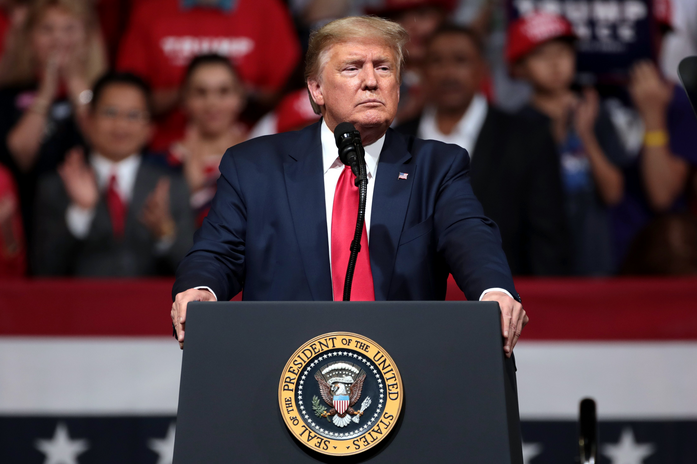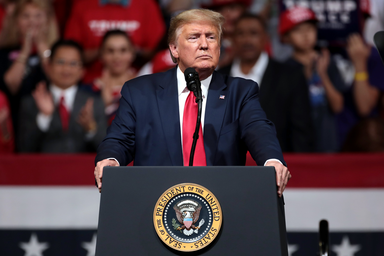It is important to know who you are voting for. Here are some facts about and policy stances of: Donald Trump
COVID-19
Donald Trump’s COVID-19 response is under intense scrutiny by many; in the earliest stages of the virus, Trump called the virus a political hoax. He also Tweeted to ‘LIBERATE’ the states under lockdown in order to flatten the curve. Whitehouse.gov states that Donald Trump took all the necessary steps in order to prevent COVID-19 from coming into the United States, with screenings at international airports, as well as other protective measures. However, the United States’ COVID-19 deaths are above 200,000, and there are almost 7,000,000 active cases. Trump has also shown continuous disdain for wearing masks, which the CDC states is one of the most effective ways in stopping the spread of the virus.
Donald Trump and his administration claim to be working to expedite a vaccine and support citizens who have been impacted by the virus financially, and his administration claims to do that until the virus has subsided. However, the last stimulus check to be sent out was for $1,200, and it was in April. It is now almost October. The promised vaccine is, according to Donald Trump, very close to being released. However, according to scientists at the Mayo Clinic, realistically it will be 12-18 months before an effective vaccine.
Healthcare
The Trump administration vows to end the Affordable Care Act, more popularly known as Obamacare. He claims it is harming Americans, and has done continuous work on repealing certain portions of the Act. He revoked the subsidies that the previous administration had paid in order to keep premiums and costs down for all Americans. The Trump Administration’s main focus is on keeping drug costs down and dismantling Obamacare and subsidies from the federal government.
Donald Trump often speaks on the heroin and opioid epidemic. He and his administration claim that the CARES Act funding he sent helped to decrease this epidemic, as well as claiming bills he has signed have alone decreased opioid prescriptions being written and filled by 31%. However, during the Coronavirus time period, opioid overdoses have increased by 18%. Trump has not commented on the spike in overdoses, but insists his plans and legislation have been effective.
The Economy
Since Donald Trump was a businessman before becoming president, he promised a lot of progress for the growth and improvement of the American economy. Under his presidency, there have been 7 million more jobs added and the unemployment rate is 1.4% lower than the Congressional Budget Office projections. That would make unemployment the lowest it has been in half a century. Now, with COVID-19 there was an increase in April that is now starting to decline. Currently the unemployment rate is 8.4%. As for debt, Trump’s efforts to reduce it have not succeeded. The national debt has grown from $20 trillion in 2017 to $24 trillion as of April 2020. According to Balance.com Trump said he could “borrow knowing that if the economy crashed, you could make a deal. The U.S. will never default because you can print the money.” This is concerning because it could cause U.S. currency to be devalued. Moving forward, Trump wants to use $1 trillion to rebuild infrastructure, eliminate outsourcing of jobs, and does not want to raise the minimum wage from $7.25 because he believes it will make businesses less competitive.
College Debt
Trump has not proposed to cancel all student loan debt like many of the candidates who were running for the presidency this year. He supports it in a different type of way. Trump wants to implement income-driven repayment plans. Also, in order to help pay off loans faster Trump wants to simplify the system to one repayment plan. The plan includes offering student loan forgiveness after 15 years of payment instead of the current 20 years. Forbes reports, “In exchange for receiving five years of fewer monthly student loan payments, you would pay 12.5% of your discretionary income under the Trump plan compared with 10% under some current income-driven repayment plans.” Trump does not support tuition-free college and wants to eliminate Public Service Loan Forgiveness, arguing that it would save the federal government more money by not having to forgive the billions of dollars in loans.
Race Relations
A reoccuring remark made by President Trump is that he has done the most for the black community “since Abraham Lincoln.” He also tweeted a statement that he had the lowest African American poverty, crime and unemployment rates in history. Let’s investigate racial justice initiatives, progress in the Black community, and race relations:
For racial justice initiatives across the board, one of Donald Trump’s moves has included banning what he believes to be ‘anti-American’ diversity training from federal agencies. Across the board, racial justice initiatives have seemed to struggle under his leadership as 6 in 10 Americans said race relations were generally bad in January. In addition, when looking at specific minority groups “Nearly 6 in 10 considered Trump’s actions to be bad for Hispanics and Muslims, and about half said they were bad for African Americans” according to AP News. Discrimination against Asian Americans can also be seen surging during the Coronavirus pandemic as 83% of the Asian American labor force filed for unemployment insurance in California, compared to 37% of the rest of the state’s labor force. More policy specific racial problems can be seen in the immigration section for certain minority groups.
When looking at African-American issues specifically, the African-American unemployment rate reached a record low of 5.5% in September of last year, according to BBC. This downward trend in African-American unemployment began in the Obama presidency where it went from 12.6% to 7.5%, and continued in the first three years under the leadership of President Trump. However, it increased to 16.8% in May of this year. Although that is largely a side effect of the coronavirus pandemic, African Americans were disproportionately impacted—their unemployment 3.5% higher than the overall amount.
Similarly, poverty rates have been declining since 2010 and in 2018 (the last time poverty levels were recorded) the African-American poverty rate was 20.8%, making it the lowest on record.
When looking at crime rates, it is not easy to find crime categorized by race, as the FBI do not have a comprehensive log of this. However, violent crime generally has been falling since 1991 and African-American arrests have been dropping since 2010, but stayed mostly steady throughout the Trump Presidency.
When looking at race relations as a whole, “two-thirds of Americans think that Trump has increased racial tensions in this country after George Floyd’s death” according to NPR News. Due to this, his job approval is now at only 41% and his disapproval rate is at 55%—the highest in his entire presidency. Not only is this disapproval rating high, but 47% of Americans say they strongly disapprove. NPR also states that “9 in 10 Democrats and African Americans think he’s increased racial tension, as do almost three-quarters of independents and 63% of whites.” These are very high numbers and do not look well for Donald Trump’s re-election campaign.
Criminal Justice
According to NPR News, Trump’s record on criminal justice is contradictory due to his 2016 acceptance speech which stated that “the crime and violence that today afflicts our nation will soon, and I mean very soon, come to an end.” This summer, the Trump Administration announced sending federal agents into cities to fight what the Justice Department termed as a “sudden surge of violent crime.”
Trump’s First Step Act for criminal justice reform was passed with bipartisan support in Congress as it reformed sentencing, expanded drug treatment programs and lessened harsh penalties for crack cocaine possession. In addition, Trump signed an executive order in June providing federal grants to improve police training and create a national database for police misconduct. Both improvements, while a step in the right direction, have been criticized for falling short. The Trump administration does support the death penalty and tried to restart executions of federal death row inmates, but the request was rejected by the US Supreme Court in December, according to Reuters.
Immigration
According to the Migration Policy Institute, President Trump made an ambitious stance on immigration right from the beginning of his campaign and presidency. Among his initiatives were five executive orders related to immigration within days of each other in January 2017 as summarized below:
-
Banned nationals of eight countries, most majority-Muslim, from entering the United States.
-
Reduced refugee admissions to the lowest level since the resettlement program was created in 1980.
-
Reversed the decline in arrests of unauthorized immigrants in the U.S. interior that had occurred during the last two years of the Obama administration.
-
Cancelled the Deferred Action for Childhood Arrivals (DACA) program, which is currently providing work authorization and temporary relief from deportation to approximately 690,000 unauthorized immigrants brought to the United States as children.
-
Ended the designation of Temporary Protected Status for nationals of Haiti, Nicaragua and Sudan, and signaled that Hondurans and possibly Salvadorans may also lose their work authorization and protection from removal in 2018. (Immigration under Trump: A Review of Policy Shifts in the Year Since the Election, Pierce & Selee, December 2017)
Even with Trump’s paramount policy shifts, the support of the courts, state and local jurisdictions were not as accepting as President Trump had initially hoped for.
Women’s Rights & Issues
According to the White House, Trump is committed to the economic empowerment of women, and he has launched the Women’s Global Development and Prosperity Initiative which aims to advance women’s roles in the global economy. Additionally, Ivanka Trump, the president’s daughter, told CNBC that women are thriving in Trump’s economy. Ivanka Trump said unemployment rates for women are the lowest they’ve been since the 1950s. The Trump Administration also approved 12 weeks of paid family leave for federal workers, which are the same benefits that those in the military already receive.
According to CNN, Trump has also vowed to appoint a woman to the Supreme Court to replace the late Ruth Bater Ginsburg.
“It will be a woman, a very talented, very brilliant woman,” Trump said at a campaign rally in North Carolina. “I haven’t chosen yet, but we have numerous women on the list.”
However, there are a number of reasons why the 2017 Women’s March took place just a day after President Trump was inaugurated. One of the most prominent reasons may be the 2005 tape of him and Billy Bush bragging about sexual conquests with women. On the recording, Trump “describes trying to have sex with a married woman” and “brags about women letting him kiss and grab them because he is famous.” Another reason the Women’s March on Washington took place was the numerous sexual assault allegations against him. According to Business Insider, “at least 26 women have accused President Donal Trump of sexual misconduct since the 1970s.”
Additionally, Trump has made it clear that he will defund Planned Parenthood, a nonprofit organization that provides reproductive healthcare, and he will look over the Supreme Court case Roe v. Wade to determine if it should be repealed. Roe v. Wade was the case that protected a woman’s right have an abortion. According to USA Today, Trump is the first ever president to speak at the annual March for Life rally, and he has made efforts to abolish safe abortions and restrict access to contraceptives.
According to The Hill, Trump has seen a decrease in support from women voters. In 2016, he won the support of 52% of white women and 61% of white women without college degrees. Now, that support has lessened. Trump’s campaign hopes that the work he has done for women in the economy, including his strides for paid family leave, will earn back the support of American women.
LBGTQ+ Issues
In a recent video released by Log Cabin Republicans on Twitter, Richard Grenell, a member of the Republican Party, stated that President Trump is the “most pro-gay president in American history.” Grenell is America’s first openly gay cabinet member, appointed by Trump to be the Acting Director of National Intelligence, and he claims that Trump has been supportive of gay marriage since the day Trump was sworn into office. Additionally, according to Reuters, Trump pledged to help decriminalize homosexuality in other countries in a speech at the United Nations.
“We stand in solidarity with LGBTQ people who live in countries that punish, jail or execute individuals based upon sexual orientation,” Trump said in front of world leaders.
However, LGBTQ+ rights activists believe Trump has not shown support for the LGBTQ+ community in his time as president. According to NPR News, the Trump Administration has rolled back on the progress made for the LGBTQ+ community. For example, in 2019, Trump’s revised transgender military ban was approved by the U.S. appeals court, despite it being in violation of constitutional rights. In 2017, not long after he was inaugurated, Trump repealed the transgender student guidance that makes schools respect a student’s gender identity. Title IX still protects transgender students from discrimination. In cases of child welfare, Trump’s Administration allows child welfare organizations to choose whether they do not want to work with prospective parents if they are gay.
According to The Hill, the head of the Human Rights Campaign, Alphonso David, said Donald Trump said that he is rolling back multiple Obama-era protections for the LGBTQ+ community, which makes him “the worst president on LGBTQ issues ever.” David’s remarks were in response to Trump’s decision to allow faith-based adoption agencies to discriminate against LGBTQ+ families.
Climate Change
Trump does not believe in the seriousness of climate change, and he removed the United States from the Paris Climate Agreement. He denies evidence of climate change often, most recently in the California wildfires. He currently has no plan on his campaign or White House website on how to handle climate change, only the economic benefits of using nonrenewable energy sources.





